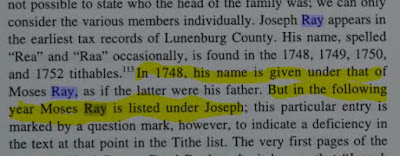The importance of looking at the Original Lists
Yesterday I received copies of the original tithe lists for Lunenburg County, Virginia from the Library of Virginia. I ordered them to make sure the format of the lists were the same in the book "Sunlight on the Southside" and the original lists. I was only interested in two lists my ancestor was named on. He disappears from the lists in 1750, which is the year he likely relocated to a place up near the James River. Joseph continues to be named on the lists until the county of Bedford is formed from Lunenburg County.
The individual original lists take up about 2 pages on 11x17 paper. Each list covers a specific geographical area of the county. My ancestor only appeared on the lists in 1748 and 1749.
The lists I was interested in were for the area called "mouth of the falling water upwards", which covered the Maggoty Creek area of today's Franklin County, Virginia.

After reviewing the two original lists I ordered I noticed immediately that the originals aren't formatted exactly like the book "Sunlight on the Southside".
First of all the original 1748 tithe list has Moses Wray, or Ray, on the top line and because of lack of space to list more than two on a line Joseph Ray is below them.
The 1748 list in "
Sunlight on the Southside" lists the men differently which created confusion. Moses Ray is listed first with Benjamin and Joseph listed next, and their names are indented. If your ancestor isn't listed with others then this isn't a problem. The fact our Rays were recorded as a family and they formatted the names differently than the original records led us to believe the first name listed was the head of the household and likely the father of the other two.
In 1749 again the list was formatted differently. This time only Joseph and Moses appear on the lists. I believe Benjamin probably aged out of paying tithes? Below we see Joseph and Moses listed on the same line.
In the book "Sunlight on the Southside" the formatting has Joseph above Moses, instead of on the same line like the original. Again creating confusion regarding how the men are related? Also we see the last name is spelled differently than in the book. It's spelled Raa in the original and Rea in the book.
The book "The Genesis of the Virginia Frontier: The Origins of Franklin County, Virginia, 1740-1785, by T. Keister Greer copied their information from "Sunlight on the Southside" which led them to draw the wrong conclusion about the possible relationship of the men. The snippet below does state that it is confusing regarding the order of the men on the tax lists, but the author assumes there is a problem with the tithe lists. Actually there is just a problem with the list copy in the book.
What do the lists tell us?
The most important thing the tithe lists tell us is that Benjamin, Moses, and Joseph all lived in the same household, in 1748 and 1749, because they are listed and numbered as a single family unit. Either they were brothers or Benjamin was their father and Moses and Joseph were brothers? I do believe Benjamin was the father of Moses and Joseph, and possibly of Benjamin. We know from the traveler who visited Benjamin in the 1750's he was an older man. He doesn't appear on tithe lists in the 1750s, even though we know he lived in that county then, likely because he aged off lists. My ancestor Moses Wray had a son named Benjamin, who I believe he named after Moses' father.
I also noticed the surname Anderson on these lists. I previously thought my ancestor Anderson Wray's first name was of Scottish origin. This may not be the case since there are some researchers who say they have traced a maternal line back to an Anderson family. So the name Anderson may actually come from a surname?
The lists also tell what general area the family lived in at the time these tithes were taken because each tithe taker was assigned to a specific area. There is a map showing the area each tithe taker covered.
Unimportant Information?
The more I work on my family history the more I understand any piece of information on a document could turnout to be important. Even a piece of information on a document that may not seem to be helpful on first examination may later turn out to be useful. We know that he format of transcribed information is important.
Reading through the introduction to the "Sunlight on the Southside" book the paragraph below states the names of slaves were omitted from the book because they were unimportant.
I am seeing the names of slaves on these original lists (see images below). There are only first names, but even first names are important from a genealogical standpoint. Former slaves often took the surname of their masters
, for instance, which could help their descendants trace their families using these records. Even for descendants of slave owners this information could help in identifying an ancestor through the names of their slaves.
Since all information on a document can be relevant it is important to get a copy of the original document, if it still exists, and not rely on a transcribed copy.
How do we confirm the relationships of the Ray or Wray men?
I think the only hope for establishing the exact relationship of these men would be if something like a family bible surfaces or a court document? Church records for the mid 18th century were likely destroyed during the Civil War. Something that might surface at this point would probably be from a Wray descendant who migrated out of the area.










No comments:
Post a Comment